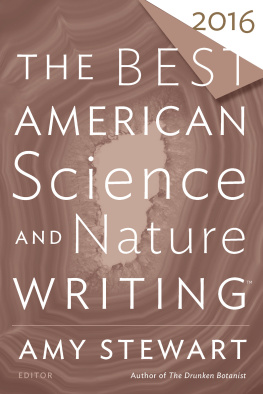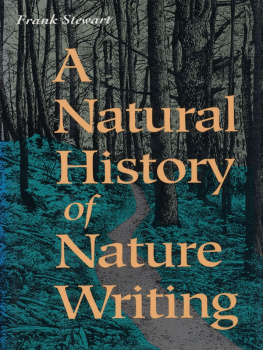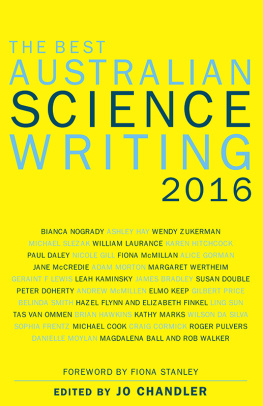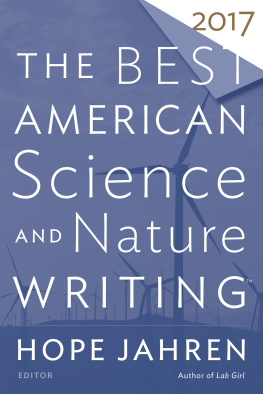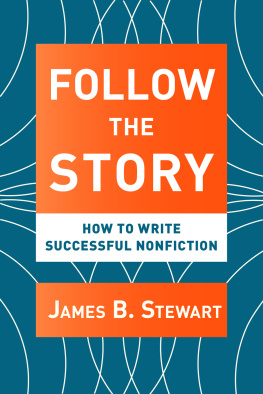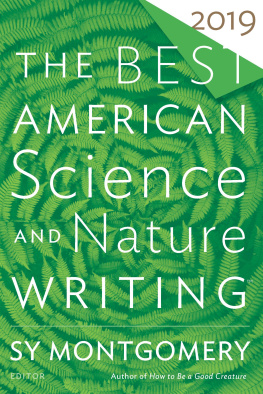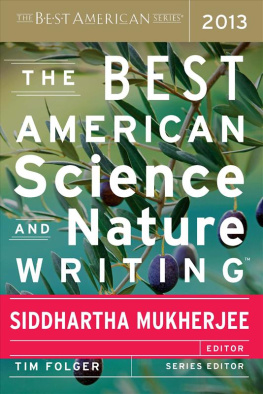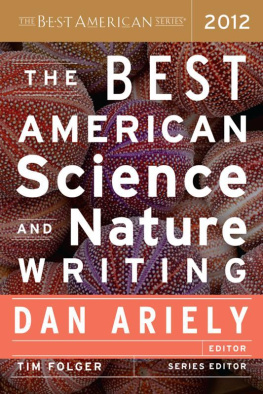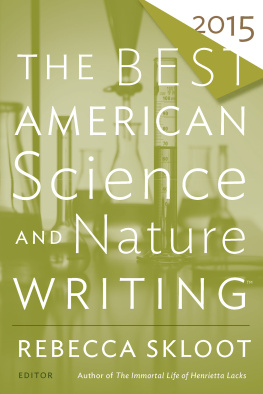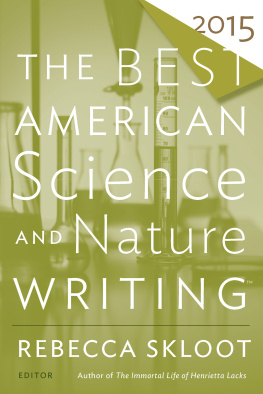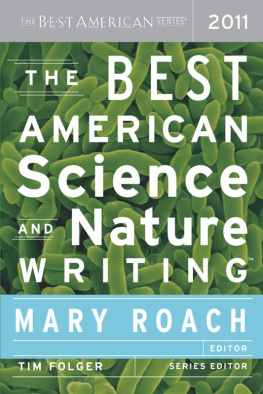Copyright 2016 by Houghton Mifflin Harcourt Publishing Company
Introduction copyright 2016 by Amy Stewart
ALL RIGHTS RESERVED
The Best American Science and Nature Writing is a trademark of Houghton Mifflin Harcourt Publishing Company. The Best American Series is a registered trademark of Houghton Mifflin Harcourt Publishing Company.
No part of this work may be reproduced or transmitted in any form or by any means, electronic or mechanical, including photocopying and recording, or by any information storage or retrieval system without the proper written permission of the copyright owner unless such copying is expressly permitted by federal copyright law. With the exception of nonprofit transcription in Braille, Houghton Mifflin Harcourt is not authorized to grant permission for further uses of copyrighted selections reprinted in this book without the permission of their owners. Permission must be obtained from the individual copyright owners as identified herein. Address requests for permission to make copies of Houghton Mifflin Harcourt material to or to Permissions, Houghton Mifflin Harcourt Publishing Company, 3 Park Avenue, 19th Floor, New York, New York 10016.
www.hmhco.com
ISSN 1530-1508
ISBN 978-0-544-74899-6
Cover design by Christopher Moisan Houghton Mifflin Harcourt
Cover photograph Science Photo Library/SuperStock
e ISBN 978-0-544-74964-1
v1.0916
Back to the Land by Chelsea Biondolillo. First published in Orion, MarchApril 2015. Copyright 2015 by Chelsea Biondolillo. Reprinted by permission of Chelsea Biondolillo.
Tracking Ivory by Bryan Christy. First published in National Geographic, September 2015. Copyright 2015 by Bryan Christy. Reprinted by permission of Bryan Christy.
They Helped Erase Ebola in Liberia, Now Liberia Is Erasing Them by Helene Cooper. First published in the New York Times, December 9, 2015. 2015 by the New York Times. All rights reserved. Used by permission and protected by the copyright laws of the United States. The printing, copying, redistribution, or retransmission of this content without express written permission is prohibited.
Rotten Ice: Traveling by Dogsled in the Melting Arctic by Gretel Ehrlich. First published in Harpers Magazine, April 2015. Copyright 2015 by Harpers Magazine. All rights reserved. Reproduced from the April issue by special permission.
Why Are Sports Bras So Terrible? by Rose Eveleth. First published on Racked.com, October 29, 2015. Copyright 2015 by Racked.com. Reprinted by permission of Vox Media, Inc.
The Man Who Tried to Redeem the World with Logic by Amanda Gefter. First published in Nautilus, February 5, 2015. Copyright 2015 by Nautilus. Reprinted by permission of Nautilus.
A Very Naughty Little Girl by Rose George. First published in Longreads, March 10, 2015. Copyright 2015 by Rose George. Reprinted by permission of Rose George.
The Irrationality of Alcoholics Anonymous by Gabrielle Glaser. First published in The Atlantic, April 2015. Copyright 2015 by Gabrielle Glaser. Reprinted by permission of Gabrielle Glaser.
Thirty Million Gallons Under the Sea by Antonia Juhasz. First published in Harpers Magazine, June 2015. Copyright 2015 by Harpers Magazine. All rights reserved. Reproduced from the June issue by special permission.
The Bed-Rest Hoax by Alexandra Kleeman. First published in Harpers Magazine, December 2015. Copyright 2015 by Alexandra Kleeman. Reprinted by permission of Harpers Magazine.
The Siege of Miami by Elizabeth Kolbert. First published in The New Yorker, December 21 and 28, 2015. Copyright 2015 by Elizabeth Kolbert. Reprinted by permission of Elizabeth Kolbert.
Whats Left Behind by Kea Krause. First published in The Believer, Fall 2015. Copyright 2015 by Kea Krause. Reprinted by permission of Kea Krause.
The Will to Change by Robert Kunzig. First published in National Geographic, November 2015. Copyright 2015 by National Geographic Society. Reprinted by permission.
The Modern Moose by Amy Leach. First published in Ecotone, Spring 2015. Copyright 2015 by Amy Leach. Reprinted by permission of the Wylie Agency, LLC.
The Lost Girls by Apoorva Mandavilli. First published in Spectrum, October 19, 2015. Copyright 2005 by the Simons Foundation. Reprinted by permission of Apoorva Mandavilli.
Solar, Eclipsed by Charles C. Mann. First published in Wired, December 2015. Copyright 2015 by Charles C. Mann. Reprinted by permission of Charles C. Mann.
Return of the Wild by Emma Marris. First published in Boom: A Journal of California, Fall 2015. Copyright Emma Rohwer (Emma Marris). Reprinted by permission of Emma Rohwer.
Perfect Nails, Poisoned Workers by Sarah Maslin Nir. First published in the New York Times, May 11, 2015. Copyright 2015 by the New York Times. All rights reserved. Used by permission and protected by the copyright laws of the United States. The printing, copying, redistribution, or retransmission of this content without express written permission is prohibited.
Attack of the Killer Beetles by Maddie Oatman. First published in Mother Jones, May/June 2015. Copyright 2015 by the Foundation for National Progress. Reprinted by permission.
The Whole Universe Catalog by Stephen Ornes. First published in Scientific American, July 2015. Copyright 2015 by Stephen Ornes. Reprinted by permission of Stephen Ornes.
Bugged by Rinku Patel. First published in Popular Science, August 2015. Copyright 2015 by Purvi Patel. Reprinted by permission of Purvi Patel.
My Periodic Table by Oliver Sacks. First published in the New York Times Sunday Review. July 24, 2015. Copyright 2015 by Oliver Sacks. Reprinted by permission of the Wylie Agency, LLC.
The Really Big One by Kathryn Schulz. First published in The New Yorker, July 20, 2015. Copyright 2015 by Kathryn Schulz. Reprinted by permission of Kathryn Schulz.
Begin Cutting by Gaurav Raj Telhan. First published in Virginia Quarterly Review, Fall 2015. Copyright 2015 by Gaurav Telhan. Reprinted by permission of Gaurav Telhan.
Telescope Wars by Katie Worth. First published in Scientific American, December 2015. Copyright 2015 by Katie Worth. Reprinted by permission of Katie Worth.
Foreword
I F, BY CHANCE , this anthology is read a century from now, what might those future readers make of it? First they would need to place the book in the context of its era, a pivotal one for all the worlds inhabitants, human and nonhuman alike. Perhaps theyll recall that 2015 was the year our civilization established a grim new benchmark: the concentration of carbon dioxide in our planets atmosphere reached 400 parts per million for the first time in recorded history, a level not seen since at least two million years ago, during the Pliocene epoch. Earth might as well have been another world then. Our own species, Homo sapiens, had not yet evolved; the average global temperature was five to seven degrees warmer; sea levels were anywhere from 16 to 130 feet higher than today.
In what sort of world will those future readers dwell? That depends on us and the choices we make over the next decade. Will we finally end our dependence on fossil fuels and avoid disaster? Will we be praised for our foresight or cursed for our shortsighted selfishness? Will historians in the 22nd century condemn our reckless dismissal of the increasingly urgent warnings of our best scientists? This much is certain: if we fail to act, it wont be because we didnt understand the magnitude of the threat.
As I began writing this foreword, James Hansen, the eminent Columbia University climate scientist, discussed the crisis in a video released to coincide with the publication of a startling new paper. The paper, which Hansen wrote with 18 coauthors from around the world, makes for sobering reading. He and his colleagues argue that we are perilously close to irreversibly dooming our descendants to the most catastrophic effects of climate change. Have we passed a point of no return? he asked in the video. I doubt it, but its conceivable. He added: We are in a position of potentially causing irreparable harm to our children, grandchildren, and future generations. This is a tragic situation because it is unnecessary. We could already be phasing out fossil fuel emissions. All thats lacking is a commitment to action.
Next page
